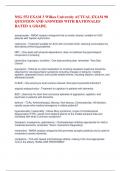NSG 552 EXAM 3 Wilkes University ACTUAL EXAM 90
QUESTION AND ANSWERS WITH RATIONALES
RATED A GRADE.
acamprosate - NMDA receptor antagonist that is renally cleared, suitable for AUD
patients with hepatic dysfunction.
naltrexone - Treatment suitable for AUD with comorbid OUD, reducing consumption by
decreasing reinforcing properties.
NRT - Only deals with physical dependence, does not address the psychological
component of smoking.
varenicline, bupropion, clonidine - Oral stop-smoking aids, remember *Very Bad
Cancer*
buproprion - Patients on what medication for smoking cessation treatment should be
observed for neuropsychiatric symptoms including changes in behavior, hostility,
agitation, depressed mood, and suicide-related events, including ideation, behavior, and
attempted suicide.
IV BZD - How would you treat cocaine induced chest pain/myocardial infarction?
atypical antipsychotics - Treatment for agitation in patients with dementia.
BZD - Used only for short term and acute episodes of aggression, agitation, and
psychosis in patients with dementia.
delirium - TCAs, Anticholinergics, Benzos, Non-benzos, Corticosteroids, H2 blockers,
opioids cause what medical emergency in elderly patients?
hypersexuality, hyperorality - Klüver-Bucy syndrome, a type of frontotemporal
degeneration (FTD), results from bilateral lesions of the medial temporal lobe and
manifests with what 2 common symptoms?
Donepezil, rivastigmine, galantamine - Cholinesterase inhibitors appropriate for mild to
moderate dementia, remember *Damn, Grandma's Regressing*
memantine - NMDA receptor antagonist that promotes synaptic plasticity and is used for
moderate to severe dementia.
nortiptyline - TCA with fewest anticholinergic effects, making it the most appropriate
TCA in the elderly *SSRIs ARE PREFERRED*
, mirtazapine - Most appropriate medication for elderly patient with MDD, insomnia, and
decreased appetite.
naloxone - MOA: Pure opioid antagonist that competes and displaces opioids at opioid
receptor sites.
methadone, buprenorphine, buprenorphine+naloxone - Treatments for opioid use
disorder.
buprenorphine+naloxone - Treatment for opioid use disorder with comorbid pain.
opioids - Inappropriate use of what substance may be due to uncontrolled pain?
tablet, injectable, implant - Naltrexone delivery methods.
implant - Form of naltrexone limited to inpatient use.
buprenorphine - Mu receptor partial agonist for opioid withdrawal.
buprenorphine - Taking this medication too soon after last opioid use increases the
chances of intense withdrawal that comes on very quickly (precipitated withdrawal).
opioid intoxication - Symptoms include nausea and vomiting, respiratory depression,
constipation, itching, mioisis (small pupil). Patient will experience euphoria and
sedation.
opioid withdrawal - Symptoms include N/V/D and dehydration, irritability, restlessness,
yawning, and twitching, increased HR/BP, chills, increased temperature, rhinorrhea,
lacrimation, dilated pupils.
naloxone - Treatment for opioid intoxication during which cardiac or respiratory
depression is a concern.
cocaine intoxication - Symptoms include dilated pupils, HA, tremor, hyper-reflexia,
twitching, seizures, or coma, increased HR/BP, arrhythmias, and MI, N/V,
incontinence/ARF, or rhabdomyolysis
cocaine intoxication - Treatment includes BZD, antipsychotics, and management of
medical problems including HTN, stroke, cardiac arrhythmias, hyperthermia, and
seizures.
cocaine - The use of beta blockers for treatment of chest pain and MI during this
intoxication is to be avoided due to unopposed a adrenergic stimulation.




